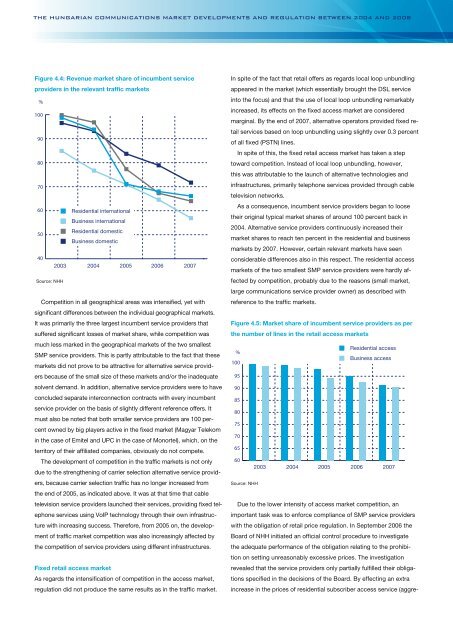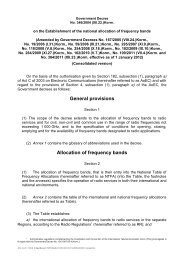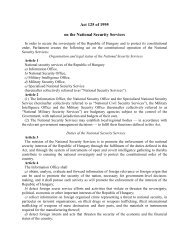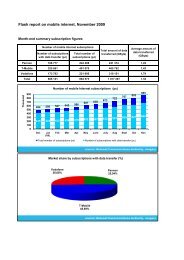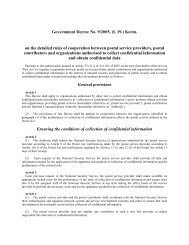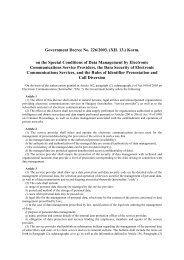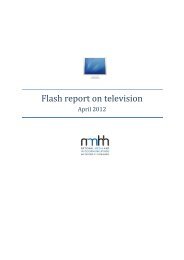The Hungarian Communications Market Developments and ...
The Hungarian Communications Market Developments and ...
The Hungarian Communications Market Developments and ...
You also want an ePaper? Increase the reach of your titles
YUMPU automatically turns print PDFs into web optimized ePapers that Google loves.
<strong>The</strong> <strong>Hungarian</strong> <strong>Communications</strong> <strong>Market</strong> <strong>Developments</strong> <strong>and</strong> Regulation between 2004 <strong>and</strong> 2008<br />
Figure 4.4: Revenue market share of incumbent service<br />
providers in the relevant traffic markets<br />
%<br />
100<br />
90<br />
80<br />
70<br />
60<br />
Residential international<br />
Business international<br />
Residential domestic<br />
50<br />
Business domestic<br />
40<br />
2003 2004 2005 2006 2007<br />
Source: NHH<br />
Competition in all geographical areas was intensified, yet with<br />
significant differences between the individual geographical markets.<br />
It was primarily the three largest incumbent service providers that<br />
suffered significant losses of market share, while competition was<br />
much less marked in the geographical markets of the two smallest<br />
SMP service providers. This is partly attributable to the fact that these<br />
markets did not prove to be attractive for alternative service providers<br />
because of the small size of these markets <strong>and</strong>/or the inadequate<br />
solvent dem<strong>and</strong>. In addition, alternative service providers were to have<br />
concluded separate interconnection contracts with every incumbent<br />
service provider on the basis of slightly different reference offers. It<br />
must also be noted that both smaller service providers are 100 percent<br />
owned by big players active in the fixed market (Magyar Telekom<br />
in the case of Emitel <strong>and</strong> UPC in the case of Monortel), which, on the<br />
territory of their affiliated companies, obviously do not compete.<br />
<strong>The</strong> development of competition in the traffic markets is not only<br />
due to the strengthening of carrier selection alternative service providers,<br />
because carrier selection traffic has no longer increased from<br />
the end of 2005, as indicated above. It was at that time that cable<br />
television service providers launched their services, providing fixed telephone<br />
services using VoIP technology through their own infrastructure<br />
with increasing success. <strong>The</strong>refore, from 2005 on, the development<br />
of traffic market competition was also increasingly affected by<br />
the competition of service providers using different infrastructures.<br />
Fixed retail access market<br />
As regards the intensification of competition in the access market,<br />
regulation did not produce the same results as in the traffic market.<br />
In spite of the fact that retail offers as regards local loop unbundling<br />
appeared in the market (which essentially brought the DSL service<br />
into the focus) <strong>and</strong> that the use of local loop unbundling remarkably<br />
increased, its effects on the fixed access market are considered<br />
marginal. By the end of 2007, alternative operators provided fixed retail<br />
services based on loop unbundling using slightly over 0.3 percent<br />
of all fixed (PSTN) lines.<br />
In spite of this, the fixed retail access market has taken a step<br />
toward competition. Instead of local loop unbundling, however,<br />
this was attributable to the launch of alternative technologies <strong>and</strong><br />
infrastructures, primarily telephone services provided through cable<br />
television networks.<br />
As a consequence, incumbent service providers began to loose<br />
their original typical market shares of around 100 percent back in<br />
2004. Alternative service providers continuously increased their<br />
market shares to reach ten percent in the residential <strong>and</strong> business<br />
markets by 2007. However, certain relevant markets have seen<br />
considerable differences also in this respect. <strong>The</strong> residential access<br />
markets of the two smallest SMP service providers were hardly affected<br />
by competition, probably due to the reasons (small market,<br />
large communications service provider owner) as described with<br />
reference to the traffic markets.<br />
Figure 4.5: <strong>Market</strong> share of incumbent service providers as per<br />
the number of lines in the retail access markets<br />
Residential access<br />
%<br />
Business access<br />
100<br />
95<br />
90<br />
85<br />
80<br />
75<br />
70<br />
65<br />
60<br />
2003 2004 2005 2006 2007<br />
Source: NHH<br />
Due to the lower intensity of access market competition, an<br />
important task was to enforce compliance of SMP service providers<br />
with the obligation of retail price regulation. In September 2006 the<br />
Board of NHH initiated an official control procedure to investigate<br />
the adequate performance of the obligation relating to the prohibition<br />
on setting unreasonably excessive prices. <strong>The</strong> investigation<br />
revealed that the service providers only partially fulfilled their obligations<br />
specified in the decisions of the Board. By effecting an extra<br />
increase in the prices of residential subscriber access service (aggre-


